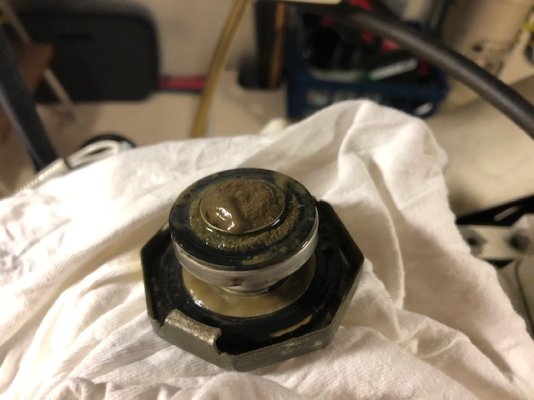mijmoto
Veteran Member
- Joined
- May 17, 2016
- Messages
- 34
- Location
- USA
- Vessel Name
- Rincon Feliz
- Vessel Make
- Kadey-Krogen 48 North Sea
Hi All, Recently purchased a 2001 Kadey-Krogen 48 North Sea with only 1,400 hours on the engine. The main power source is a John Deere 6068. This boat has mostly been used as a condo and we have seen a number of problems related to this. At survey the cooling system was pressure checked which required the removal of the pressure cap on top of the heat exchanger. All was normal and holding pressure. On the sea trial it was noted that at WOT the engine temp got to about 210 degrees F so was noted as slight overheating.
After 1,200 miles and a couple of hundred engine hours we asked a yard to look into the cooling problem. They sea trialed the boat and confirmed the temp rise that was seen at survey. When the same pressure cap was removed a frothy oil residue was observed on the cap and in the neck of the exchanger (see attached). There was no oily residue on top of the coolant and the coolant looked good in the overflow reservoir. A coolant sample was taken for analysis and no oil was noted in the sample. At this point I asked the yard to stop.
I am new to boat ownership but have fairly extensive mechanical experience and have some thoughts of my own as well as the speculation of the yard. Any thoughts or ideas as to the source of the oil in the coolant? Could it be a one time event based on a little used engine? Where should I start on my diagnosis? Thanks. Jim
After 1,200 miles and a couple of hundred engine hours we asked a yard to look into the cooling problem. They sea trialed the boat and confirmed the temp rise that was seen at survey. When the same pressure cap was removed a frothy oil residue was observed on the cap and in the neck of the exchanger (see attached). There was no oily residue on top of the coolant and the coolant looked good in the overflow reservoir. A coolant sample was taken for analysis and no oil was noted in the sample. At this point I asked the yard to stop.
I am new to boat ownership but have fairly extensive mechanical experience and have some thoughts of my own as well as the speculation of the yard. Any thoughts or ideas as to the source of the oil in the coolant? Could it be a one time event based on a little used engine? Where should I start on my diagnosis? Thanks. Jim


